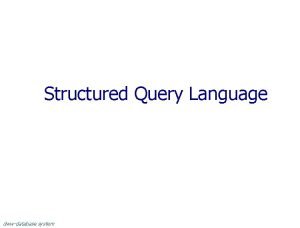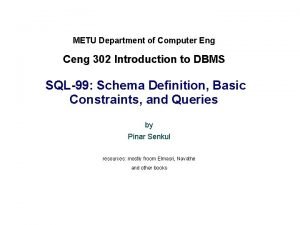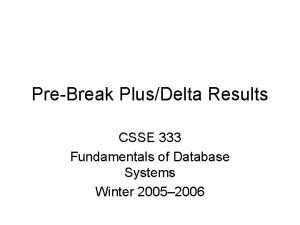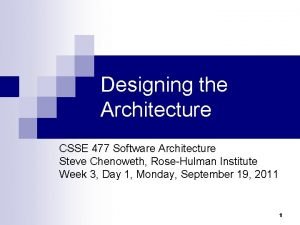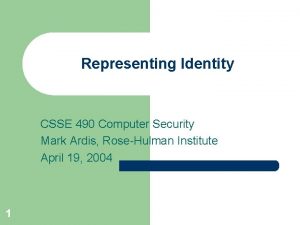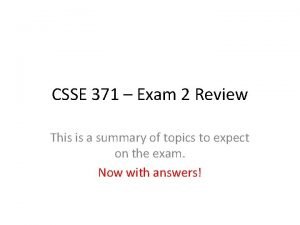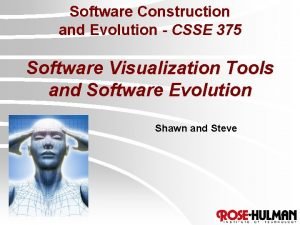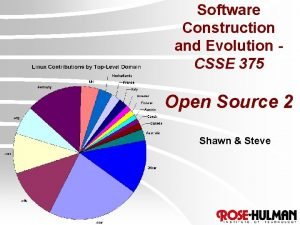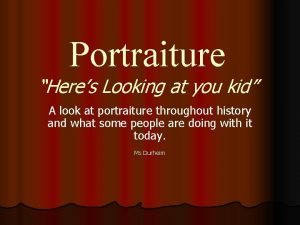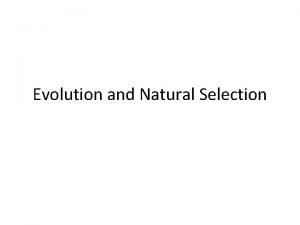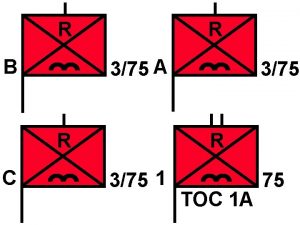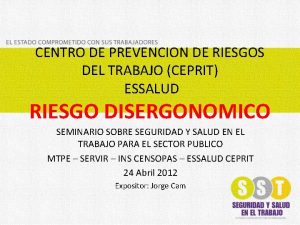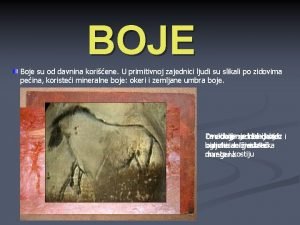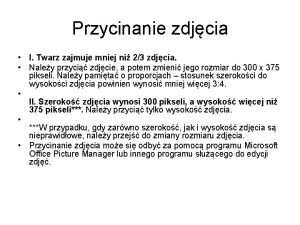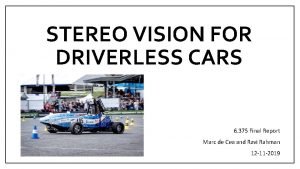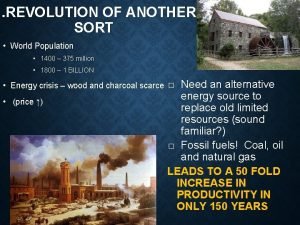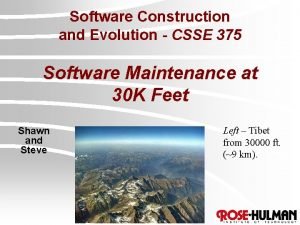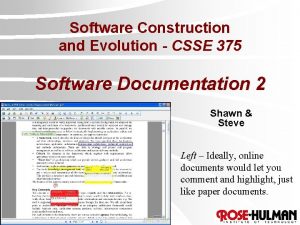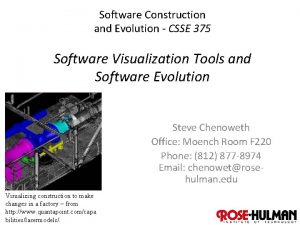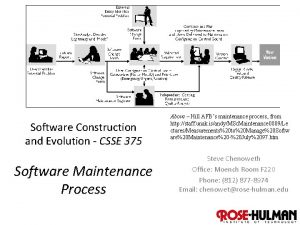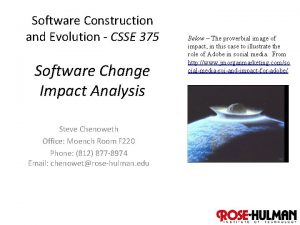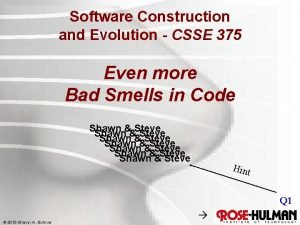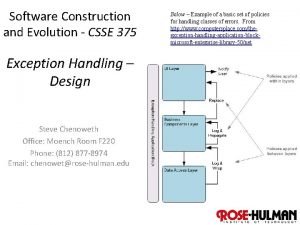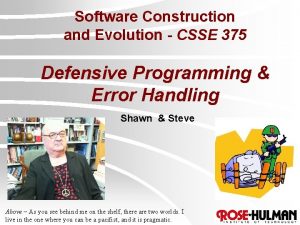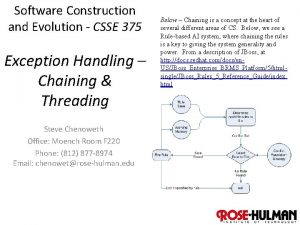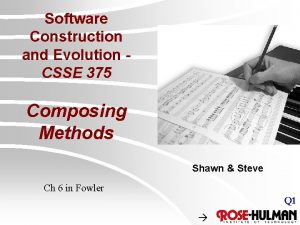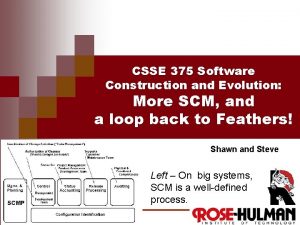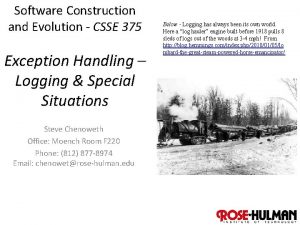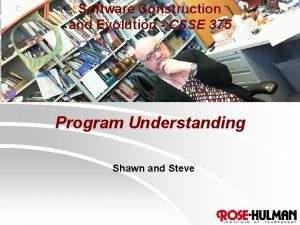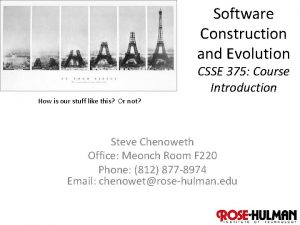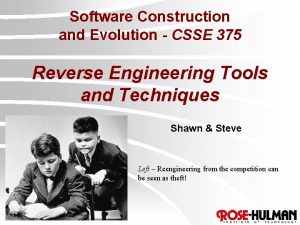Software Construction and Evolution CSSE 375 Heres why


















- Slides: 18

Software Construction and Evolution - CSSE 375 “Here’s why you need the new wheels, too…” Software Maintenance Process Shawn and Steve Left – Maintenance process is driven by the ongoing ability to make money at it.

Recall Discretionary and Non-Discretionary $ v Since Development and Maintenance can be somewhat ambiguous situations, money often determines the label l l v Or, “when it is” l v Lots of money, or a little Out of a fixed budget, or not Before or after first release Or, whether it’s mostly fixes vs features 2

What’s the business case for maintenance? v Large systems, like O/S’s: l l v Customers build / load a lot on top of them. Essentially an obligation to support for a long time. – E. g. , Windows XP supported for 10 years. – Ubuntu has “long term releases” of Linux May have long-term maintenance agreements. – Paid for by customers v May have Quality of Service agreements. – Also paid for. v Custom software products – You may get paid “by the fix” – Time and materials, or – “Value pricing” v A good final exam question: “Why is it hard to make money on customer fixes for major customers? Maintaining old products retains customers l Maybe they’ll buy new things, too? 3

Development versus Maintenance Risk v Development Risks l l v Technology - sometimes bleeding edge Personnel - sometimes high turnover – And new people right out of school Budget - risk entrepreneurial investments Business - business case based on future customers Maintenance Risks l l Technology - sometimes technology obsolete Personnel - sometimes dated skills – Same people on the project forever? Budget - risk averse cost containment Business - business case based on existing customers – What do they need (and will pay for)? – What does it take to keep them? – How to move them to new products? Q 1 4

Key Software Maintenance Factors v Software Product v User Requirements (i. e. , Change Request and Specification) v Organizational Environment v Operational Environment v Maintenance Personnel v Maintenance Process 5

Software Product v Application domain v Documentation quality v Code flexibility v Code complexity/structure v Product quality Q 2 6

User Requirements v Requests for additional features v Correction of defects (bugs) v Other support (e. g. training, help desk) Q 3 7

Organizational Environment v Change in Policies l Medical – FDA 13485 Medical Device Regulation v Competition v Internal Management Changes l Mergers and Acquisitions 8

Operational Environment v Hardware v Communications v Operating Systems v Systems Software v Third Party Software Q 4 9

Maintenance Personnel v Staff Turnover l v What’s the “truck factor”? Application Domain Expertise l Anthem only wants people who “know Medicare part B” “Didn’t we fix that last year? ” v Working Practices l Efficiency is very important! Q 5 10

Ingredients of a Maintenance Process (1 of 2) Process requests before working on them: l l l l Capture maintenance requests Deal with Emergency Fixes/Priority CRs Investigate change requests – Verify bugs from DRs/PRs – Understand the impacts (1 st Impact Analysis) Estimate the Effort / Cost Prioritize requests – Competing against other requests! Assigning to maintenance release and team Scheduling the maintenance release Q 6 11

Ingredients of a Maintenance Process (2 of 2) Conduct detailed Impact Analysis v v v Update estimates Plan the change strategies Update Requirements (as needed) Design the Changes v v Plan the implementation Update Design (Architecture, Logical, Physical) Implement and Integrate the Changes Test Changes with Various Configurations Deciding to send it out v Special, or in a specific sub-release Deploy the Release Q 7 12

Example Maintenance Process “Pre-fixing” v Help Desk v Technical Support v Maintenance Personnel v Customers instead of Users! v http: //www. indiawebdevelopers. com/Customer. Support/mainten ance_process. asp 13

Example: Hill Air Force Base http: //www. stsc. hill. af. mil/crosstalk/1997/07/stark 1. gif. 14

Maintenance in the System Life Cycle ISO/IEC 15288 System Life Cycle Processes ENTERPRISE ENVIRONMENT MANAGEMENT INVESTMENT MANAGEMENT SYSTEM LIFE CYCLE MANAGEMENT RESOURCE MANAGEMENT SYSTEM LIFE CYCLE (25) ENTERPRISE(5) AGREEMENT (2) PROJECT (7) QUALITY MANAGEMENT ACQUISITION SUPPLY PROJECT PLANNING PROJECT ASSESSMENT PROJECT CONTROL DECISION MAKING RISK MANAGEMENT CONFIGURATION MANAGEMENT INFORMATION MANAGEMENT TECHNICAL (11) STAKEHOLDER REQUIREMENTS DEFINITION REQUIREMENTS ANALYSIS ARCHITECTURAL DESIGN IMPLEMENTATION INTEGRATION VERIFICATION TRANSITION VALIDATION OPERATION MAINTENANCE DISPOSAL 15

Maintenance in the Software Life Cycle IEEE/EIA 12207 Software Life Cycle Processes SOFTWARE LIFE CYCLE (17+1) SUPPLY DEVELOPMENT OPERATION MAINTENANCE PRIMARY (5) SUPPORTING (8) ACQUISITION DOCUMENTATION CONFIGURATION MANAGEMENT QUALITY ASSURANCE VERIFICATION VALIDATION JOINT REVIEW AUDIT PROBLEM RESOLUTION ORGANIZATIONAL (4) MANAGEMENT INFRASTRUCTURE IMPROVEMENT TRAINING TAILORING Q 8 16

12207’s Maintenance Process A Primary Life Cycle Process - 12207. 0 § 5. 5 (ISO/IEC 14764) Defines the basic activities of the maintainer: managing modifications to the software product to keep it current and in operational fitness. Activity 1 Process Implementation Tasks Document maintenance activities, problem tracking procedures, & Manage modifications to the system. 2 Problem and modification Analyze problem reports. Replicate or verify analysis problems. Develop modifications. Document problems, analysis, fixes. Get modifications approved. 3 Modification implementation Document where changes are needed. Implement modifications and test. 4 Maintenance review/ Review integrity of modified system. Get approval for acceptance modifications. 5 Migration Ensure products meet standard. Develop and use Migration Plan. Notify users of migration. Conduct parallel operations if needed. Notify all concerned, archive all records. Perform post-op review of changes. Keep data from old environment. 6 Software retirement Document plans for retirement. Notify all users of plans and activities. Conduct parallel operations. Notify all concerned, archive all records. Keep data from retired product per contract. 17

Maintenance Process Standards ISO/IEC 14764 • Process Implementation • Problem and modification analysis • Modification implementation • Maintenance review/acceptance • Migration • Software retirement IEEE STD 1219 • Problem identification • Analysis • Design • Implementation • System test • Acceptance test • Delivery 18
 Relational sql
Relational sql Ceng 302
Ceng 302 Csse results
Csse results Software architecture cartoon
Software architecture cartoon Representing identity in information security
Representing identity in information security Csse exam
Csse exam Evolution construction software
Evolution construction software Evolution construction software
Evolution construction software Why why why why
Why why why why Heres to you jesusa
Heres to you jesusa Heres to right now
Heres to right now The art heres look
The art heres look Heres hank
Heres hank Enemy mechanized infantry section symbol
Enemy mechanized infantry section symbol Rm 375-tr-2008
Rm 375-tr-2008 Berlinsko plavo
Berlinsko plavo 300 x 375 pikseli
300 x 375 pikseli Com(2018) 375 final
Com(2018) 375 final 1400/375
1400/375
